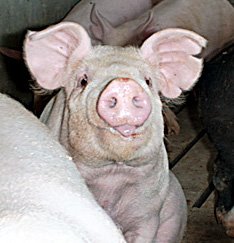
I took this last fall but it's one of my favorite (click pic for larger). I think the red ones in the foreground are dogwoods, the rest we call tulip poplars - they can get mighty tall.
"The gravitational attraction of the Earth endows objects with weight and causes them to fall to the ground when dropped."So, can someone tell me how this little guy gets airborne? Look at those tissue wings on that big hairy body. It's like sewing candy wrappers onto a bear and expecting it to pull flight maneuvers. Smokey the Bear should be so endowed.
- Wikipedia


 But those weren't the effects that compelled me to study these fats years ago. It was omega-3's impact on mood and mental state that had me pouring over the research. And what a heap of mood research has come to pass since then.
But those weren't the effects that compelled me to study these fats years ago. It was omega-3's impact on mood and mental state that had me pouring over the research. And what a heap of mood research has come to pass since then."... there is enough epidemiological, laboratory and clinical evidence to suggest that omega-3 fatty acids may play a role in certain cases of depression."Mr. Logan's report contains references not just to depression, but to a variety of studies involving omega-3 and the central nervous system. They address the fat's relationship to:
"If these companies want to truly express a commitment to organics, and communicate this tangibly to their customer base, we would encourage them to specify on their label what dairy farmers and cooperatives they are "partnering with."
- Cornucopia Institute - Private Label
 Regrettably, they depend on the controversial USDA Organic Label to communicate a products' organic worthiness. Why is that regrettable?:
Regrettably, they depend on the controversial USDA Organic Label to communicate a products' organic worthiness. Why is that regrettable?:"Mostly, the [USDA] has resisted or ignored the pleas for enforcement of federal organic rules, even sitting on recommendations from their own citizens advisory committee, the National Organic Standards Board."Of course, that begs the question (from the Cornucopia's Report):
- Cornucopia Institute - Organic Dairy Report (pdf)
"Why hasn’t the USDA been strictly enforcing the regulations that are on the books? Curious readers can find documentary evidence of the incestuous relationship between the USDA, corporate lobbyists, and large political contributions in two reports:I guess I'll stick to name-brands for now:
USDA Inc.: How Agribusiness Has Hijacked Regulatory Policy at the US Department of Agriculture
A Matter of Trust: How the Revolving Door Undermines Public Confidence in Government—And What to Do About It
"The bottom line for private-label organic products, whether a dairy item or any other commodity, is "buyer beware." We encourage consumers to be vigilant and contact stores to confirm who is supplying their private-label milk or to just pay an extra quarter or two for name-brand milk from farmers and brands that are willing to be open with them and who share their values."One more point - Take note that all of the dairy products discussed here and in Cornucopia's Scorecard are "organic", and organic milk accounts for only about 1% of the milk market. Most milk out there is non-organic, or conventional, and is required to hurdle a much lower standards bar.
- Cornucopia Institute - Private Label
 I have to disagree with Dr. Autumn Fiester1 (and also mattmills, or is it tomato boy, at the Sustainable Table Blog and Kevin at the Question Technology blog who seemed to agree with her).
I have to disagree with Dr. Autumn Fiester1 (and also mattmills, or is it tomato boy, at the Sustainable Table Blog and Kevin at the Question Technology blog who seemed to agree with her).The original cloned-pig research, due in an upcoming issue of Nature Biotechnology:In her post How the Biotech Tail is Wagging the Pig Dr. Fiester said:
Generation of cloned transgenic pigs rich in omega-3 fatty acids
A NYTimes summary:
Cloned Pigs Could Provide Meat That Benefits the Heart
"... the one problem we don't have is a shortage of omega-3. Not only is it found naturally in readily available foods like walnuts and fish, but it can be found in supplements and nutritionally supplemented foods like Smart Balance Peanut Butter."I don't agree that "we don't have a shortage of omega-3". We do. Walnuts, flax seeds, and foods that contain flax seeds, e.g. Smart Balance Peanut Butter, provide the shorter-chain omega-3s2 (n-3s) which, as I've spoken about, must be converted in our bodies to the longer-chain variety3 before they reach their health-laden potential. Our bodies don't do a lot of that converting. Thus, we depend on eating the longer-chain variety of n-3s directly. Those longer-chain n-3s are found in animals, not plants4, that do the converting for us. Fish have a lot of longer-chain n-3s. But fish also have increasing levels of mercury, PCB's and other contaminants. Livestock have a little bit of n-3 naturally; they used to have more before we farmed them.
"The omega-3 pig represents the worst type of “research waste:” precious scientific resources of time, mental energy, and money that could be used to tackle serious human and environmental threats are being devoted to frivolous causes. The list of devastating problems begging for a scientific solution include: chronic, genetic, and infectious diseases ..."I don't understand her contradiction here. The chief advantage seen with consuming more n-3 (actually reducing the omega-6/omega-3 ratio) is the reduction in chronic diseases.
 The Cornucopia Institute* has ranked 68 "organic" dairy companies, on a scale of 1 to 5, based on their adherence to organic standards. You may view their scorecard here.
The Cornucopia Institute* has ranked 68 "organic" dairy companies, on a scale of 1 to 5, based on their adherence to organic standards. You may view their scorecard here.